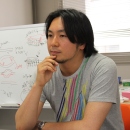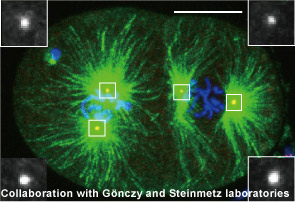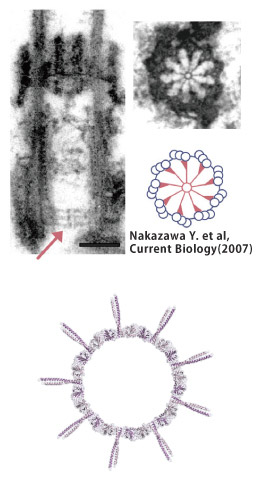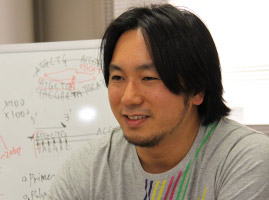KITAGAWA, Daiju D. Pha., Project Associate Professor

- Centrosome Biology Laboratory, Kitagawa Group
- Present Post (since 2011) Postdoctoral Fellow, EMBO Fellow Postdoctoral Fellow for Research Abroad, JSPS, Swiss Institute for Experimental Cancer Research, Swiss Federal Institute of Technology Postdoctoral Fellow, Graduate School of Pharmaceutical Sciences, Faculty of Pharmaceutical Sciences, University of Tokyo, Japan Ph. D., Graduate School of Pharmaceutical Sciences, Faculty of Pharmaceutical Sciences, University of Tokyo, Japan Hobbies: Football, Visiting historical places in Europe
A Major mystery in cell biology: Mechanisms of Centrosome Duplication
The centrosome is an organelle. As the nucleating point of microtubules that spread all over the cell, the centrosome is duplicated into two during cell division, forming a spindle structure and pulling and dividing the chromosomes. The centriole inside the centrosome has a peculiar shape comprised of two cylinders assembled together at a right angle. Little is known about how this complex structure is duplicated. Project Associate Professor Daiju KITAGAWA and his laboratory attempt to elucidate the mechanism of self-duplication of the centrosome, which is considered as one of the biggest mysteries in cell biology.
- Centrosome: one of the biggest mysteries in cell biology
- “Our laboratory is called ‘Centrosome Biology Laboratory.’ As far as I know, there’s no other laboratory in Japan that has the word ‘centrosome’ in its name,” says Dr. Kitagawa. Research into the centrosome is actively pursued in Western countries, while it is a less popular research theme in Japan. Why did Dr. Kitagawa choose this theme in the first place?
- “What is most fascinating about the centrosome is its duplication: how does is happen? DNA replication is widely known. The centrosome is an organelle playing a key role in cell division and chromosome segregation. We know that if the centrosome is not correctly duplicated, chromosome distribution or cell division is not performed correctly. But we know nothing about how the centrosome is duplicated. Another question is its origin.”
 The existence of the centrosome was confirmed over a century ago. The endosymbiotic theory, advanced by Lynn Margulis in the 1970s, postulated that mitochondria, chloroplasts, and centrosomes came from other organisms. Today, it is generally assumed that the theory is valid for mitochondria and chloroplasts. As for the centrosome, however, several theories have been put forward, citing spirochetes or dynamic bacteria as its origin, but most of them are invalidated today. Nothing is known as to where the centrosome is from.
The existence of the centrosome was confirmed over a century ago. The endosymbiotic theory, advanced by Lynn Margulis in the 1970s, postulated that mitochondria, chloroplasts, and centrosomes came from other organisms. Today, it is generally assumed that the theory is valid for mitochondria and chloroplasts. As for the centrosome, however, several theories have been put forward, citing spirochetes or dynamic bacteria as its origin, but most of them are invalidated today. Nothing is known as to where the centrosome is from.- “As a general tendency, the scientific community is inclined to deny the endosymbiotic theory. Since the centriole has a rather complex structure, it is not easy to explain how such a structure has gradually evolved inside the cell and become an integral part of it. When you classify organisms into those that have centrioles and those that don’t, you get the impression that centrioles appeared all of a sudden, at a certain point in time. This is why it’s not easy to totally deny the endosymbiotic theory.”
- The origin and the duplication mechanisms of the centrosome are counted among the biggest mysteries in cell biology.
- “That’s what everybody says somehow (laughter), including myself.”
- When Dr. Kitagawa obtained his doctorate, centrosome research had just reached the stage where molecules required for the formation of centrosomes were being identified, thanks to RNAi screening. He thought his knowledge and skills could be useful in advancing the research to the next major stage of determining how the molecules interact with each other to form centrosomes. Therefore, he applied for a post in a Swiss research institute internationally known for its research into centrosomes.
- “At present, research using RNAi is entirely focused on proteins. Is the centrosome entirely assembled of proteins? Perhaps other materials such as nucleic acid, saccharide and lipid may be required too. After all, no much is known about it. In the 70s, the endosymbiotic theory was proposed. In the 80s, everybody looked for DNA in the centrosome. Some papers attest to this postulation, but it is totally invalidated today. In the last two to three years, however, some scientists have been saying that they have found centrosome-derived RNA in experiments involving starfishes and clams. The material composition of the centrosome is a question that the whole research community finds fascinating, and I also think it’s a very intriguing theme.”
- Discovery of the protein SAS-6, which forms the 9-fold radial symmetry
 “What is fascinating about the centrosome is its morphological beauty,” says Dr. Kitagawa. The centriole, which is found in the middle of the centrosome, has a structure comprised of two tubes combined at a right angle. Its cross section shows a 9-fold radial symmetry like a cartwheel. While in Switzerland, Dr. Kitagawa discovered the protein that forms this structure.
“What is fascinating about the centrosome is its morphological beauty,” says Dr. Kitagawa. The centriole, which is found in the middle of the centrosome, has a structure comprised of two tubes combined at a right angle. Its cross section shows a 9-fold radial symmetry like a cartwheel. While in Switzerland, Dr. Kitagawa discovered the protein that forms this structure.- “How the centriole is made is central to the question of centrosome duplication. In the course of duplication, a tube sticks out of another tube. At this point, the 9-fold radial symmetry is already complete. I used a range of approaches to find out what molecules constitute the base of this structure.”
- Dr. Kitagawa focused on the protein SAS-6, which has been well conserved in the course of evolution and without which centrosomes cannot be duplicated. The protein looks as if it has two heads and one long narrow tail. How is this protein related to the 9-fold radial symmetry? Examining the results of X-ray structure analysis, electron-microscopic observations and computer simulations, Dr. Kitagawa concluded that 9 SAS-6 dimers form a circle, with their “heads” facing inwards and “tails” outward, like a cartwheel.
- “When we saw the electron-microscopic view of the SAS-6 dimers, we were relatively calm, feeling simply happy to see them for the first time. But when we realized that the dimers form the 9-fold radial symmetry, we all went wild, shouting “We made it!” (laughter) The discovery came from the realization that the length of a part of the base approximately corresponds to that of the tail of SAS-6. Initially, we used to think that several proteins constituted the centriole because of its complex structure. Surprisingly, a single protein makes up the 9-fold radial symmetry. We felt as if we had finally taken the first step to dissolving the mystery of centrosome duplication.”
- This much excitement – possible only as a researcher!
- When Dr. Kitagawa was a small boy, he dreamed of becoming a professional football player. He decided to become a research scientist when his research project at the Graduate School became truly interesting.
 “My priority is excitement and strong emotion (laughter). This means that I don’t have to be a research scientist. I would gladly switch jobs at any moment if I found something else that’s more exciting than the research I’m currently doing. I can’t think of anything else that can procure me this much excitement. Working on my research, I feel my adrenalin level going up and almost cry out ‘Wow!’ I think such an experience is possible for me only as a researcher, and nothing else. A football player, perhaps? I don’t mean to say I get excited like this every day; it’s only once every two or three years that a moment of great joy occurs.”
“My priority is excitement and strong emotion (laughter). This means that I don’t have to be a research scientist. I would gladly switch jobs at any moment if I found something else that’s more exciting than the research I’m currently doing. I can’t think of anything else that can procure me this much excitement. Working on my research, I feel my adrenalin level going up and almost cry out ‘Wow!’ I think such an experience is possible for me only as a researcher, and nothing else. A football player, perhaps? I don’t mean to say I get excited like this every day; it’s only once every two or three years that a moment of great joy occurs.”- Finally, I asked Dr. Kitagawa to send a message to students.
- “I want to work hard with my students. Their knowledge may be limited, but they can compensate it with their originality, creativity, or insightful ways of reasoning. That’s what I expect from students. I want to welcome to my laboratory those who truly love doing research and thinking on their own.”
- (Interviewed by Yoshiko Tamura 2011)
















